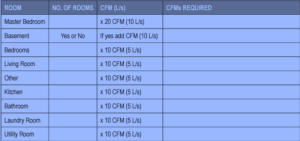As the pursuit of energy efficiency gains momentum, the integration of advanced ventilation systems has become crucial in maintaining indoor air quality while conserving energy. Energy Recovery Ventilators (ERVs) have emerged as a key solution, particularly in climates like Ontario, Canada, where extreme weather necessitates controlled ventilation for a comfortable living environment. Properly sizing ERVs is essential to ensure efficient energy utilization and effective air exchange. In this article, we will explore various methods for correctly sizing ERVs in Ontario and delve into the importance of finding the right balance between ventilation and energy conservation.
The Importance of Sizing ERVs Correctly
ERVs play a pivotal role in maintaining indoor air quality by exchanging stale indoor air with fresh outdoor air while recovering energy from the outgoing air. Incorrectly sized ERVs can lead to inadequate ventilation, resulting in poor air quality, excess humidity, and even potential health issues. Conversely, over-ventilation due to oversized ERVs can lead to unnecessary energy consumption and discomfort.
Sizing Methods for ERVs
- Minimum CFM Based on Square Footage – The Traditional Method
One of the common methods to size ERVs is by calculating the minimum Cubic Feet per Minute (CFM) required based on the square footage of the home and the number of rooms. This method accounts for the entire house’s ventilation rate at a minimum of 0.35 air changes per hour (ACH). Here is how it is done.
Step 1: Calculate the total square footage of your home, encompassing all floors.
Step 2: Multiply the square footage by the ceiling height to calculate the cubic volume of the house.
Step 3: Divide the cubic volume by 60 (to convert minutes to hours) and multiply the result by 0.35 (the desired air changes per hour).
Example: Lets size for an ERV to be placed in a 9’ ceiling, 1,250 square foot condominium with two bedrooms, one washroom, one kitchen and living space. For this example, we’ll say that all the rooms need ventilation and for the ease of calculation, all 1,250 square feet of the condo require ventilation. You first multiply the square footage of the space with the ceiling height to determine the rough cubic volume of the space. For this example, the cubic volume is 1,250 x 9 = 11,250 ft cubed. Next, you divide this value by 60 and multiply the result by 0.35; 11,250/60 x 0.35 = 65.6 CFM. This result is the minimum CFM required to ventilate the space appropriately based on the traditional method.
- Alternate Method – Room Count
The room count method offers a more nuanced perspective, considering specific CFM values for individual rooms. This method takes into account the diversity of spaces and occupancy demands, aligning with the principles of the Canadian Building Code.
Step 1: Compile a list of all rooms in your home requiring ventilation.
Step 2: Assign CFM values to each room based on the chart provided by the Canadian Building Code (section 9.32.3.3) and/or manufacturer’s recommendations. This chart considers room size, function, and occupancy.
Chart Example:

Step 3: Sum the CFM values for all rooms to ascertain the total CFM requirement for the ERV.
- ASHRAE 62.2 Method
Another credible approach involves referencing the ASHRAE 62.2 standard, which provides a systematic way to calculate minimum ventilation requirements. This method factors in the suite’s conditioned floor area and the number of occupants.
Step 1: Determine the suite’s conditioned floor area in square feet.
Step 2: Calculate the number of occupants, defined as the number of bedrooms plus one.
Step 3: Use the formula: CFM Required = 3 x (Suite Conditioned Floor Area Sq Ft / 100) + 7.5 x (No. of People).
Example: Using the same situation outlined in the example for Method 1, we’ll state that 1,250 square feet is the conditioned floor area.
CFM Required = 3 x (1,250/100) + 7.5 x (3)
CFM Required = 60
Why Oversizing ERVs Can Be Beneficial
Improved Indoor Air Quality: Oversizing ERVs slightly can enhance indoor air quality by increasing the air exchange rate. This is especially beneficial in regions like Ontario where weather extremes limit natural ventilation opportunities.
Adapting to Changing Needs: An oversized ERV can accommodate variations in occupancy, room usage, or future expansions, ensuring consistent air quality in evolving environments.
Energy Efficiency: Operating fans at their lower fan speed compared to what they are capable of is more energy efficient than a lower speed fan operating at its highest speed.
Caution: The Pitfalls of Oversizing
Increased Energy Consumption: While a slightly larger ERV might enhance air exchange, a significantly oversized system can lead to unnecessary energy usage, resulting in inflated utility bills.
Potential Discomfort: Over-ventilation due to excessive CFM can create discomfort, particularly during extreme weather conditions. This can result in drafts, temperature fluctuations, and even excessive dryness.
Striking the Right Balance
Achieving the ideal balance between ventilation and energy efficiency is paramount. When considering oversizing, moderation is key. While the benefits of slightly larger ERVs are evident, going overboard can trigger problems. For instance, oversizing an ERV by more than 20% can lead to over ventilation, negatively impacting indoor comfort and driving up energy costs.
Conclusion
Sizing ERVs appropriately is integral to optimizing indoor air quality and energy efficiency in Ontario, Canada’s climate. Through traditional methods like square footage and room count, as well as referencing standards like ASHRAE 62.2, homeowners can determine the right CFM requirements for their ERVs. The allure of oversizing ERVs for improved air exchange and adaptability is undeniable, yet the potential pitfalls of excessive ventilation and energy consumption must not be ignored. Striking the right balance ensures that ERVs effectively maintain indoor comfort and air quality while conserving energy and promoting sustainable living.
By: Nash Mohammad, B.Eng
